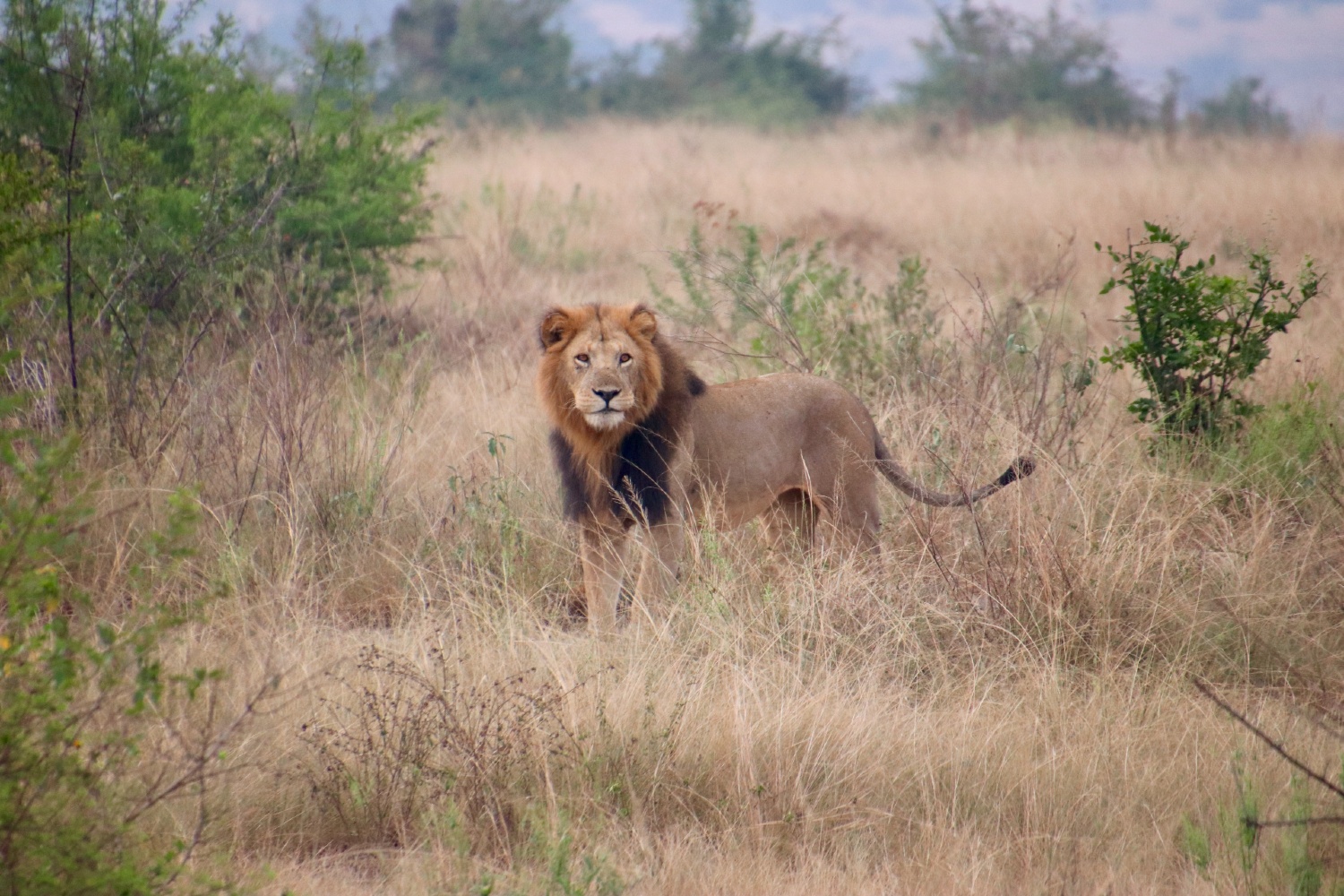
What to see, where to stay, and what to do, in Uganda / The famous silverback gorillas are certainly what put Uganda on the map for tourism. And rightly so, as it is the only part of the world where one can see these peaceful, majestic primates. There are none in captivity, so in order to spend any time with them, one must be prepared to travel far. And travel far I did, for a fleeting two hours observing them that I wouldn’t trade for anything.
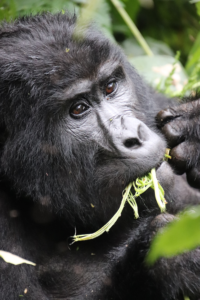
Yes, two hours. Each gorilla permit afforded me exactly sixty minutes with the silverbacks. So, what is there to do with the other 23 hours of the day? A lot, it turns out. Uganda has much more to offer tourists than the mighty silverbacks.
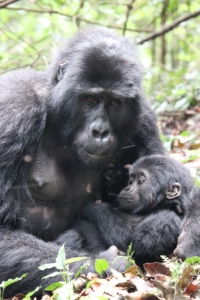
But there is far more to see in Uganda beyond the silverback gorillas. There are traditional safaris to admire the famous climbing lions of Ishasha, for example. Or, sighting the elusive shoebill in the Mabamba Swamp. A boat ride to an island of rehabilitated chimpanzees in Lake Victoria.
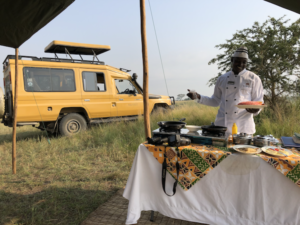
What to do in Uganda: A Wild Frontiers Safari
Wild Frontiers was our tour operator, the frontrunner for gorilla tracking and safaris in Uganda. They helped us come up with a bespoke itinerary, secured our coveted gorilla tracking permits, and allowed for some flexibility on the ground. Flights, logistics, and accommodations were well organized and generally worked like clockwork. This is Africa, after all.
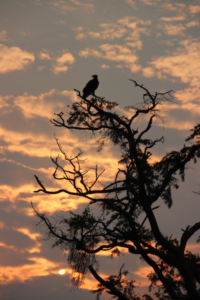
Our guides, lovely, warm-hearted locals, had studied for years to be able to tell the difference between the sound of a great blue turaco and a green-breasted pitta. Or, to be able to spot an African fish eagle from a kilometer away. They could drive for hours on end and still have the energy the next morning to prepare a pop-up omelet station on the plains.
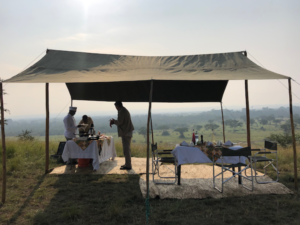
We were in constant awe of the Ugandan guides and their wealth of knowledge about the wildlife, flora, and fauna, of their country.
What to see in Uganda: Equatorial Entebbe
Uganda is a landlocked country in eastern Africa. The small city of Entebbe, about 20 miles from the bustling capital of Kampala, is where Uganda’s only international airport resides. Entebbe sits on a peninsula on the northern shore of Uganda’s largest lake, Lake Victoria.
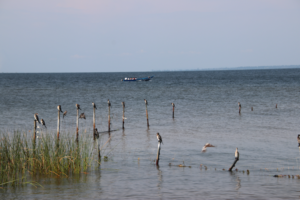
We crossed the lake, and directly through the equator, within three hours of arrival, on the way to visit the Ngamba Island Chimpanzee Sanctuary. The lake seemed angry, and our little boat was tossed around violently for nearly an hour. Spray came at us from every angle, the boat pounded the waves. My eyes remained firmly shut to keep nausea at bay. Uganda—unpredictable from the start.
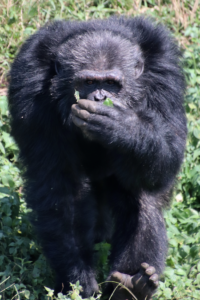
What to see in Uganda: Hungry, howling chimps
We arrived at the sanctuary, bedraggled, and soaking wet, and set off to see the 49 orphaned chimpanzees who roam the 40-acre island. That’s in comparison to the single acre allotted to the humans who work there and rehabilitate them. The chimps come to the barrier four times a day for food, and then slowly slink back into the overgrowth until the next feeding.
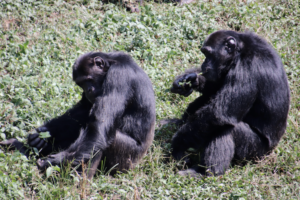
Although the feeding ritual was exciting, we were glad we didn’t plan it after our gorilla tracking later that week, as it seemed a much more commercial endeavor. We were happy to see that the orphaned chimps were well cared for, in a safe environment, and had access to medical attention should they need it.
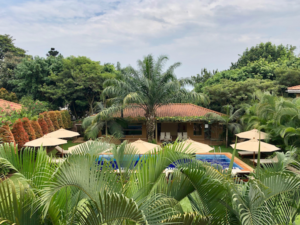
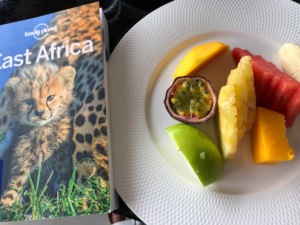
Where to stay in Uganda: Hotel No. 5
Our boutique hotel, called No. 5, was hidden in a local neighborhood less than a ten-minute drive from the airport. Here, I was to spend two nights before heading off on my own to Queen Elizabeth National Park. From there, I was to meet up with my friend at our lodging in the Bwindi Impenetrable National Park to start tracking the gorillas.
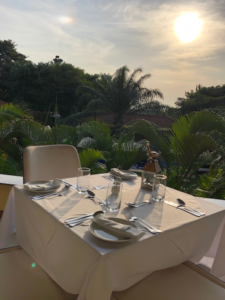
Each of the ten rooms at No. 5 faced a lush, intimate, courtyard, with overgrown tropical trees and plants. There was a charming pool set below the veranda where we would have meals and pre-dinner drinks while listening to the ongoing birdsong.
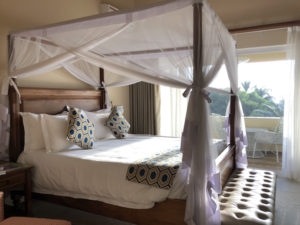
The rooms were modest, clean, and airy—the gauzy mosquito netting over the beds seemed more for show than necessity but did look quite pretty. Small balconies were a nice touch, a place to sit and listen to the hum of the surroundings. In the early morning, I heard the daily call to prayer as I drifted dreamily in and out of sleep.

Although the menus and meals were very nice at No. 5, they were surprisingly formal, a bit too heavy, and geared toward foreigners. This became a slightly disappointing theme at the various lodges we stayed at, and if I were to do it again, I would ask for more local Ugandan preparations as menu options.

What to see in Uganda: The Mabamba Swamp
While my friend worked for the few days we were in Entebbe, I took advantage of being alone with a guide and my camera. Wild Frontiers helped organize a boat trip through the wetlands of Mabamba. There, I spontaneously turned into a full-fledged bird geek. Don’t judge.
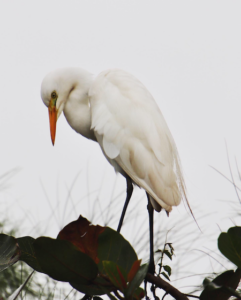

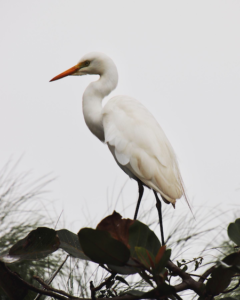
I saw statuesque egrets, metallic blue malachite kingfishers, and weightless African jacanas, to name a few aviary stand-outs.
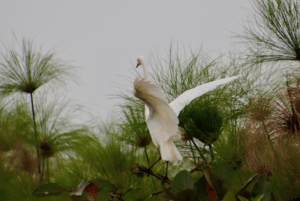
The jacanas are often referred to as Jesus birds for the way they appear to walk on water. They have a uniquely evolved prenatal care system, and can often carry multiple babies under their wings at once. I was lucky enough to capture this maternal moment in real-time.
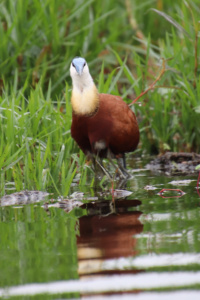
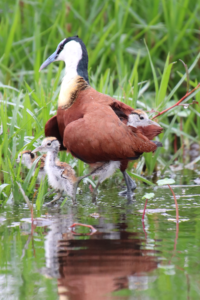
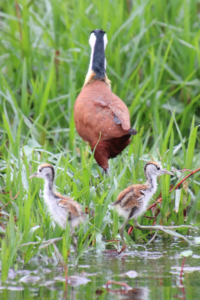
What to see in Uganda: The most famous bird you’ve never heard of
The prehistoric-looking shoebill, named for its big, clunky bill, is endangered, and numbers only twelve total across the entire 2500-hectare swamp.
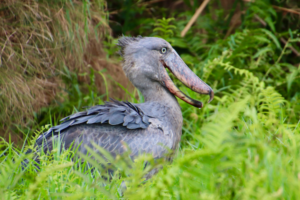
Having never heard of the shoebill, I wasn’t too bothered about finding it, but as beginners luck would have it, we saw one within the first ten minutes of the four-hour boat ride. Even my guide was thrilled to see this elusive and reclusive specimen and reached for his own camera to capture it among the reedy, wetland grasses. I was told it is one of the top five most sought-after birds to spot in Africa. Bucket list bird: check.
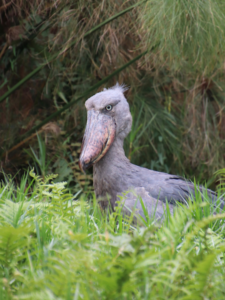
The Prettiest, Ugly Bird
A few fun facts about a bird you also may have never heard of: shoebills can grow as tall as four or five feet when fully grown; they lay only two eggs, and after a year, kill the weaker one; they can remain motionless for extended periods of time stalking their prey. The idiom, ‘beauty is in the eye of the beholder’ came to mind as I thought it was, perhaps, the prettiest, ugly bird I had ever seen.

What to do in Uganda: Get local
Instead of driving back to Entebbe from the wetlands, my guide suggested we take a car ferry across Lake Victoria. Flashbacks to yesterday’s tumultuous journey stirred in my mind, but in the name of adventure, I decided to go for it. Lake Victoria, thankfully, was much calmer, and I was able to cross with my internal organs completely intact.
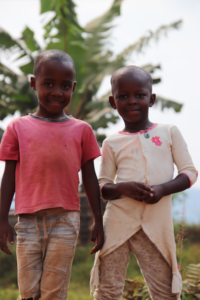
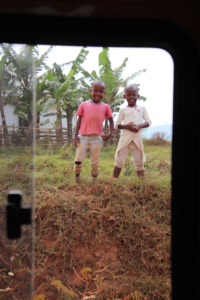
On the way to the ferry, I caught glimpses of rural Ugandan life: little girls danced in open wooden doorframes flaked with colorful paint; women peeled green bananas for makote (cooked plantains), toddlers shaved sugar cane with pangas (machetes). Mopeds kicked up clouds of red dust along the unpaved roads. Vegetable stands, roaming goats, pigs on leashes, women with bushels of fruit on their heads—an evolving portrait of village life.


While waiting at the Nakiwogo ferry dock, I was swarmed by fresh-faced and bright-eyed Ugandan kids. We took a few selfies, and they laughed at seeing themselves on screen. Teens played soccer with empty soda cans, dogs chased their own tails, and mothers fed infants while chatting with friends. That time was a gift. Quietly, I observed the villagers and thought to myself how I’d forgotten how often the simplest things in life are the best.

Where to eat in Uganda: Two Friends
Local knowledge, as they say, trumps all, which is how we found Two Friends, a restaurant situated squarely on the banks of Lake Victoria. With a convivial, remote, rustic island vibe, dangling strings of twinkling tea lights, and a menu of freshly caught Lake Victorian fish, Two Friends was a hidden gem.
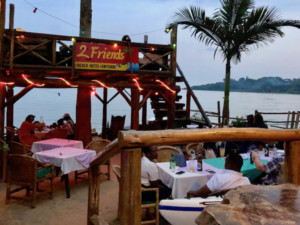
Our fish came baked in green banana leaves, served in tin foil, with all of the savory juices to mop up with the rice and veggies. The meal for three, (actually four, as we sent our idling taxi driver his meal, too) and a bottle of wine came to the economical total of $60 USD. It was one of the best meals of the trip, made most memorable by its laid-back and carefree atmosphere.
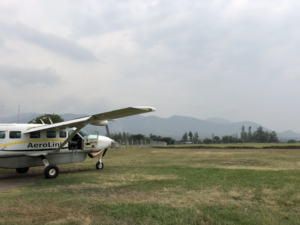
Solo travels
The next morning, I boarded a bush plane at Entebbe Airport and flew two hours to the Kihihi Airstrip located just outside of Queen Elizabeth National Park. Having never traveled solo before, I was both exhilarated and anxious. Moments after touching down, I met my guide Echy, and any fears I had dissipated. I was reminded of a Ted Talk by Ken Robinson, who advised, ‘Walk towards things that worry you.’ I started to walk.


The safari begins
On our first game drive, late that afternoon, Echy discovered a tree with a flock of gray-crowned cranes perched upon it. One by one, these magnificent birds flew effortlessly across the savannah, over the acacia and fig trees, and towards the descending sun.

Also known as the crested crane, it is the national bird of Uganda, and its likeness sits proudly on its flag. Due, in part, to poaching, it is now sadly on the endangered species list and numbers less than 20,000 in the country.
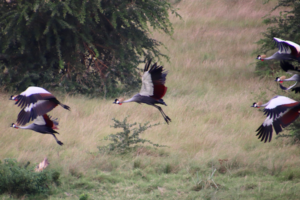
This majestic bird is distinguished by its head of rigid, golden feathers that look like the crown for which it is named. A large, fire-engine red throat pouch makes it especially easy to recognize.
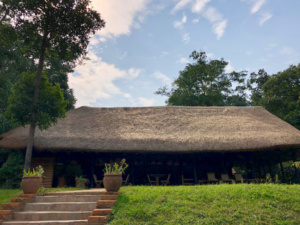
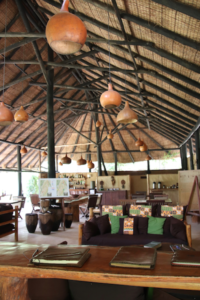
Where to stay in Uganda: Ishasha Wilderness Camp
Remembering how much I had loved tent life while in Botswana a few years ago, I was excited to get to Ishasha Wilderness Camp, which is located inside Queen Elizabeth National Park, along the Ntungwe River.
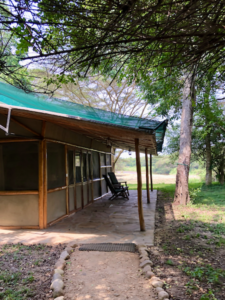
The ten permanent canvas tents are rustic, yet have everything needed to enjoy wilderness life. Each tent had a wide, stone, porch with two chairs facing the lazy river.
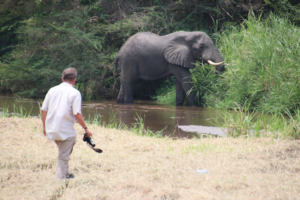
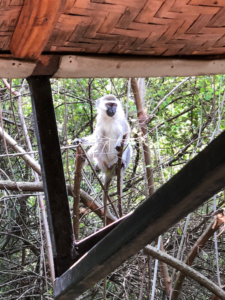
The porch felt like a front-row IMAX theater seat for BBC’s Blue Planet. A few meandering and thirsty elephants drank from the river just a few hundred yards away. A troop of cheeky vervet monkeys ran circles around my tent, both skittish and curious at the same time, scooping up their rebellious babies in an all too human-like way.
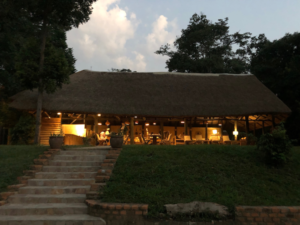

The large, thatched-roof common area was ambient, and open-air, to the river. Here, even more, elephants came to share an afternoon sundowner with us.

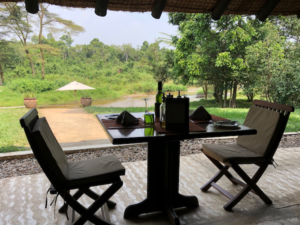
It was also where we had our meals. Being solo, I was paired with another lone traveler named Matthew—a charming headmaster from Botswana and an avid birder. Matthew became my safari partner-in-exploration for the following two days.
‘You won’t believe what I saw!’
One of the best parts of being on safari is coming back to the lodge after a game drive to compare sightings and photos with other guests.
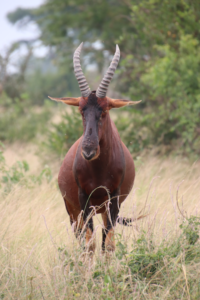
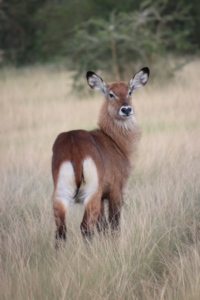
Our camp had a magnetic board so we could place markers where we had seen various wildlife each day. Depending upon who you were comparing notes with that evening, the stories sometimes became a game of oneupmanship.
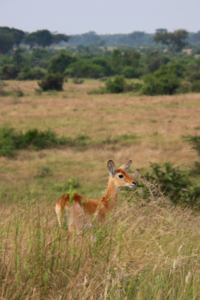
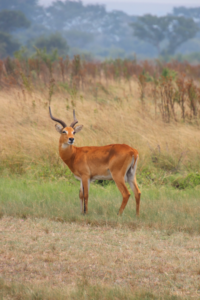
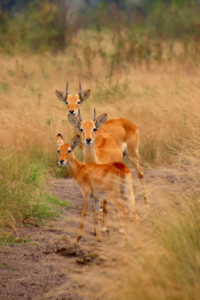
What to see in Uganda: Ishasha
At Ishasha Wilderness Camp, as opposed to No. 5, the mosquito netting was less for show, and more out of need. Yet, as a point of comparison, I have been bitten by more mosquitos while walking my dogs in DC than in my entire ten days in Uganda.

As is typical at safari camps, I was not allowed to wander back to my tent unsupervised, as the animals roam freely. No argument here. But the loveliest sounds were at night when the animals were awake, and I was tucked warmly under the covers listening to the chorus of wildlife. It was truly a shame when I finally dozed off, as hard as I tried not to, leaving the animal world behind until the morning.
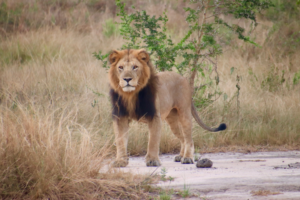
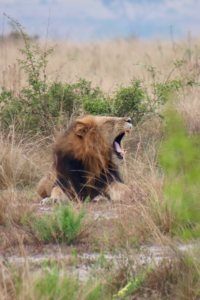
What to see in Uganda: Tree-Climbing lions
Queen Elizabeth National Park’s claim to fame is the tree-climbing lion. They are an unusual phenomenon, as lions are not adapted evolutionarily to scale trees, like leopards, for instance. Queen Elizabeth National Park is one of only two places in the world where these rare lions can be found, the other being southern Tanzania. It is widely thought that the reason for their climbing is to escape not only the pesky flies but the severe temperatures.


While lucky enough to spot a few of the beautiful lions, they simply refused to do any of their famed climbing. Content, we watched them lazing on the ground. The male lions of Ishasha are notably dark-maned, making them look even more magnificent and regal.
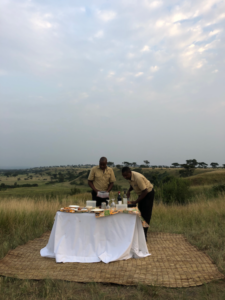
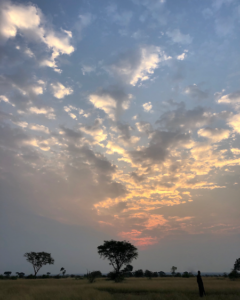
What to do in Uganda: Sundowner on the plains
There is nothing quite like sunset drinks on safari. After hours of being in a vehicle, bumping along dirt paths, it is a chance to embrace stillness and absorb the surrounding sounds. We spent an hour on the edge of a steep rift, overlooking the lush yellow and green valley below. Gin and tonic in hand, I was in my happy place.
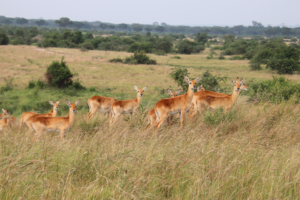
In the distance, elephants roamed, their trunks raised to grab leaves from the trees. Kobs glistened, golden and glorious, in the light. The sun tightened its grip on the landscape, wringing out the last rays of light, and casting vivid colors across the valley.
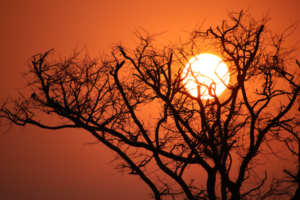
As if on cue, the sun hovered behind a spindly tree, which created an eerie, stark silhouette against the blood-red sky.
Always expect the unexpected
Every game drive is unique, which is likely why guides never get bored with their jobs. The morning I was to leave Ishasha to meet my friend in Bwindi, was one of those unexpected experiences I should have expected.
The drive was two hours, including 45 minutes to exit the boundary of Queen Elizabeth National Park. Five minutes or so into our journey, Echy jerked the jeep to a screeching halt. I did a quick scan, there was nothing to see, no animals, no movement.
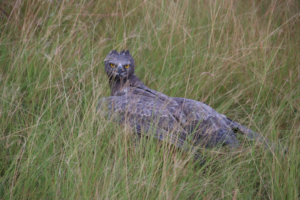
He reversed five yards, and off to the right of the jeep, camouflaged in the tall wispy grass, was a martial eagle sitting on the ground, completely still. Echy whispered to us that the eagle was strangling its prey.
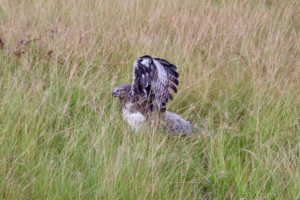
We sat silently. The eagle’s intense, beady, yellow eyes pierced through us like daggers. He was certainly not going to give up his catch on our part. A few minutes later, he flew off to a nearby dead tree to keep watch and protect his kill.

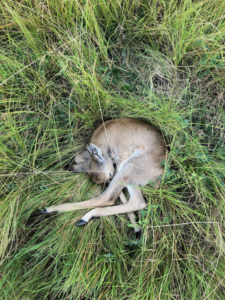
A dead baby kob, (antelope), curled up in a fetal position, lay in his wake. The kob had likely been sleeping while its mom went out to find food, but was discovered by the hungry eagle. A sad, yet realistic portrait, of the animal kingdom. How Echy spotted the eagle while cruising along at 30 mph mystifies me to this day.
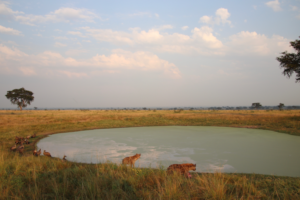
Final Notes
I was giddy from the sighting, my first ever real-time kill, so I didn’t notice Echy speaking to the driver of a passing jeep. The other driver mentioned seeing two hyenas out hunting but had unfortunately lost the trail.
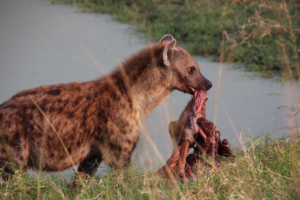
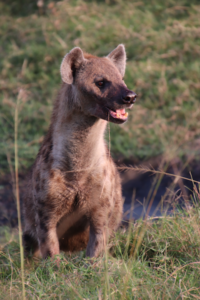
Using what can only be described as ‘Spidey-sense’, Echy looked to the distant sky, saw vultures circling, and had a hunch. He threw the jeep into gear, and lo and behold, quickly found the two hyenas devouring their freshly caught prey—another poor kob.
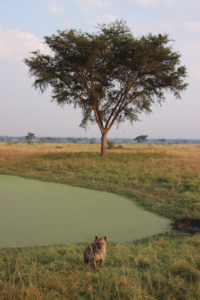
The scene was spellbinding; the light, luminous, and the pond, seafoam blue. The kob was bloody and torn to shreds. We listened to the sound of bones being crushed by the hyena’s unyielding jaws. The vultures tried to close in but were steadily kept at bay. When the hyenas were finished, they knew all too well there would be nothing left.
There is a world of adventure beyond the silverbacks in Uganda. Thank you, Echy, for showing it to me.
Be the first to know when I find a new place to get lost
Click here. Know first.

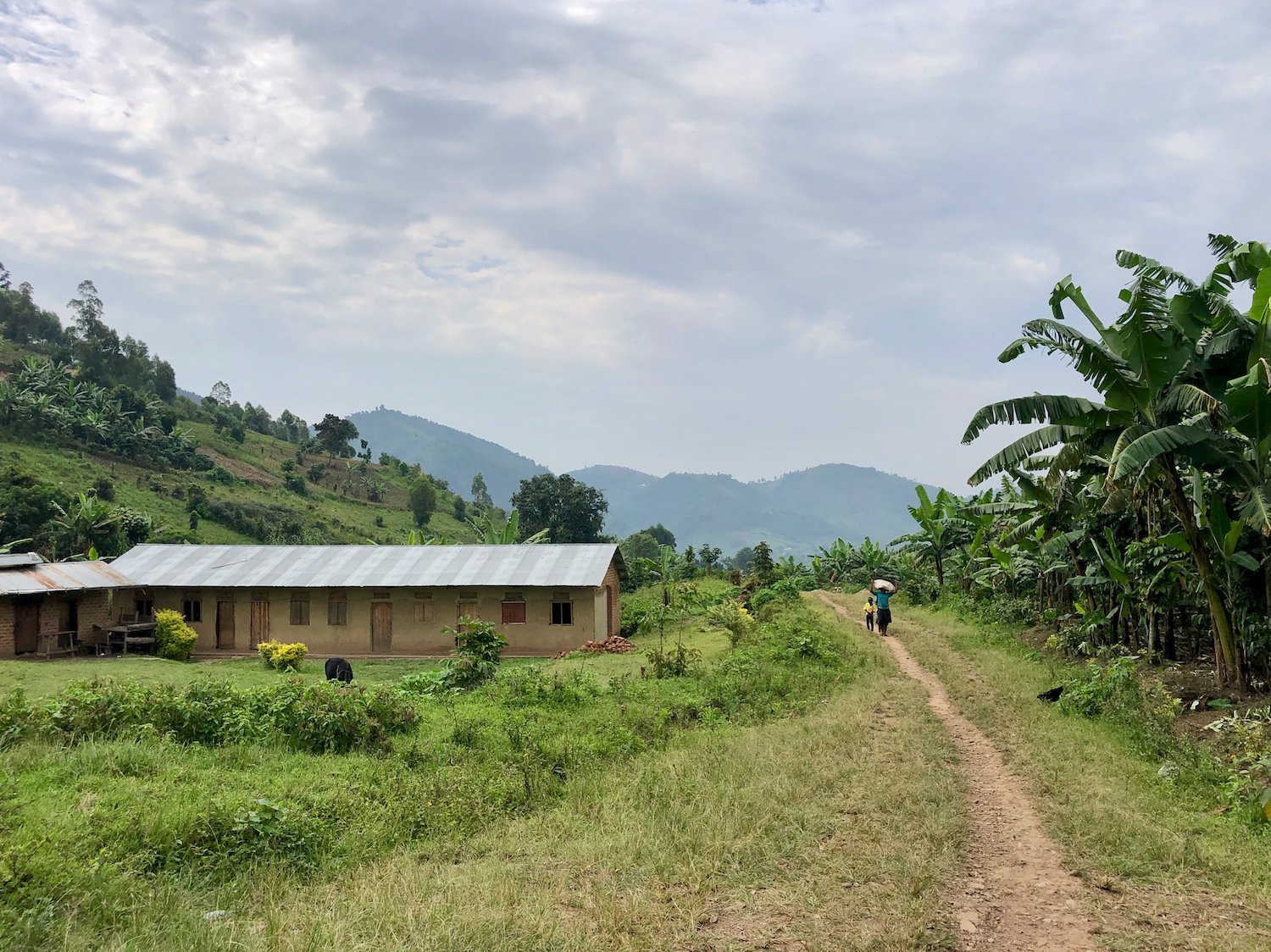
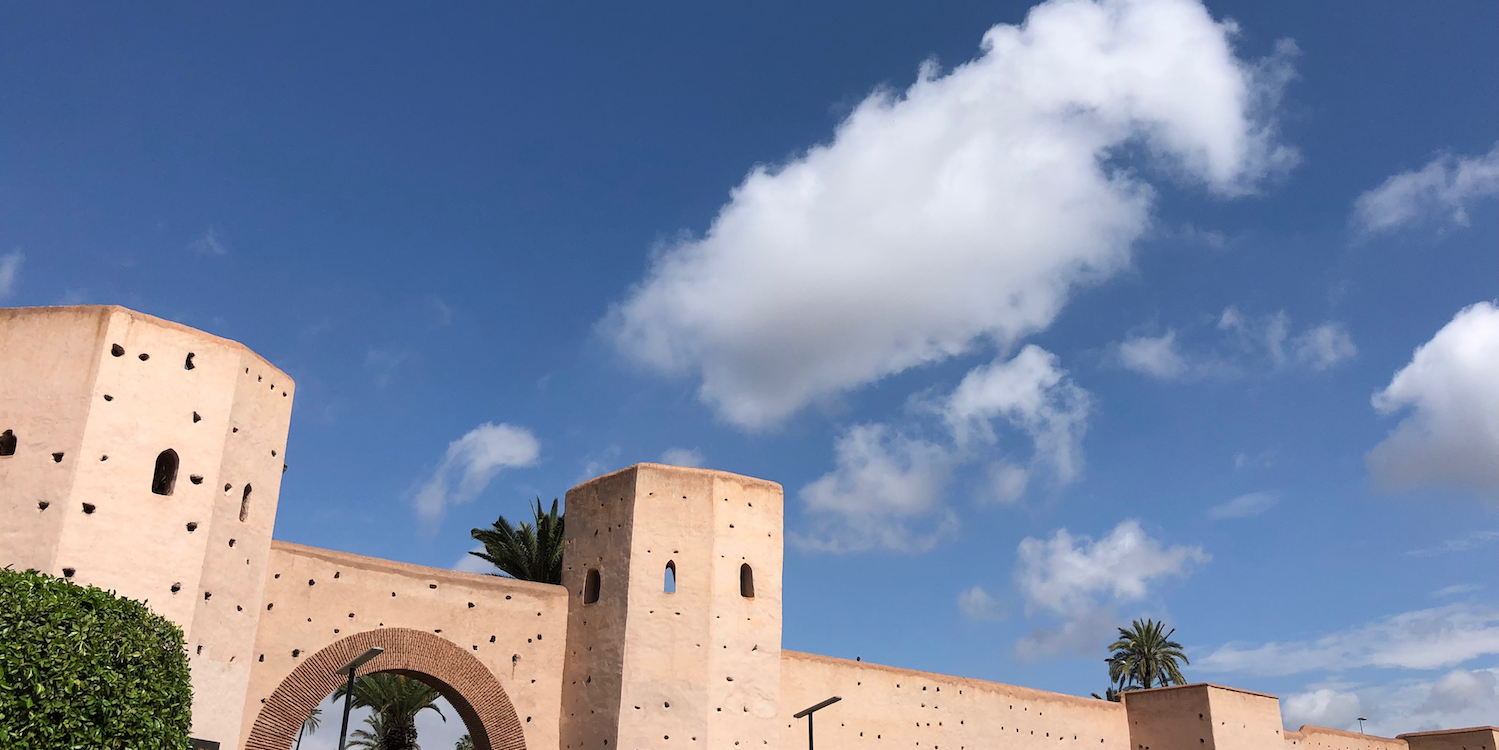
You for sharing this Informative Post